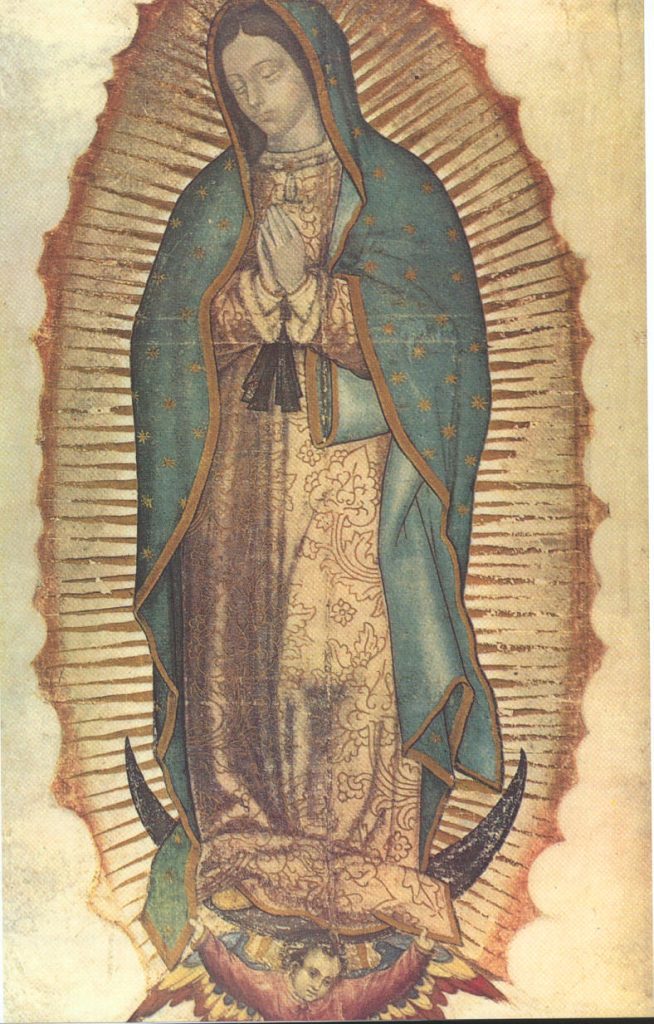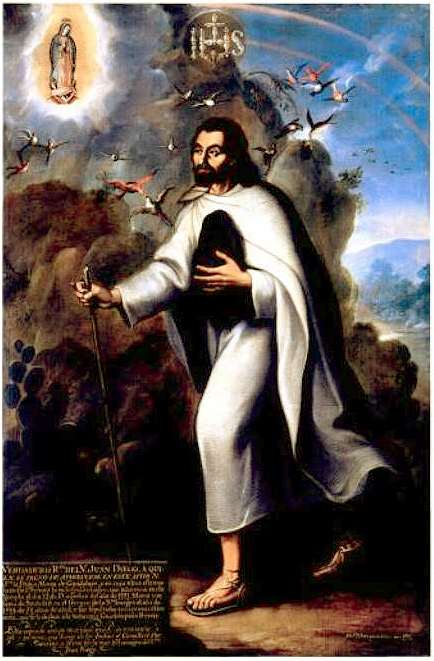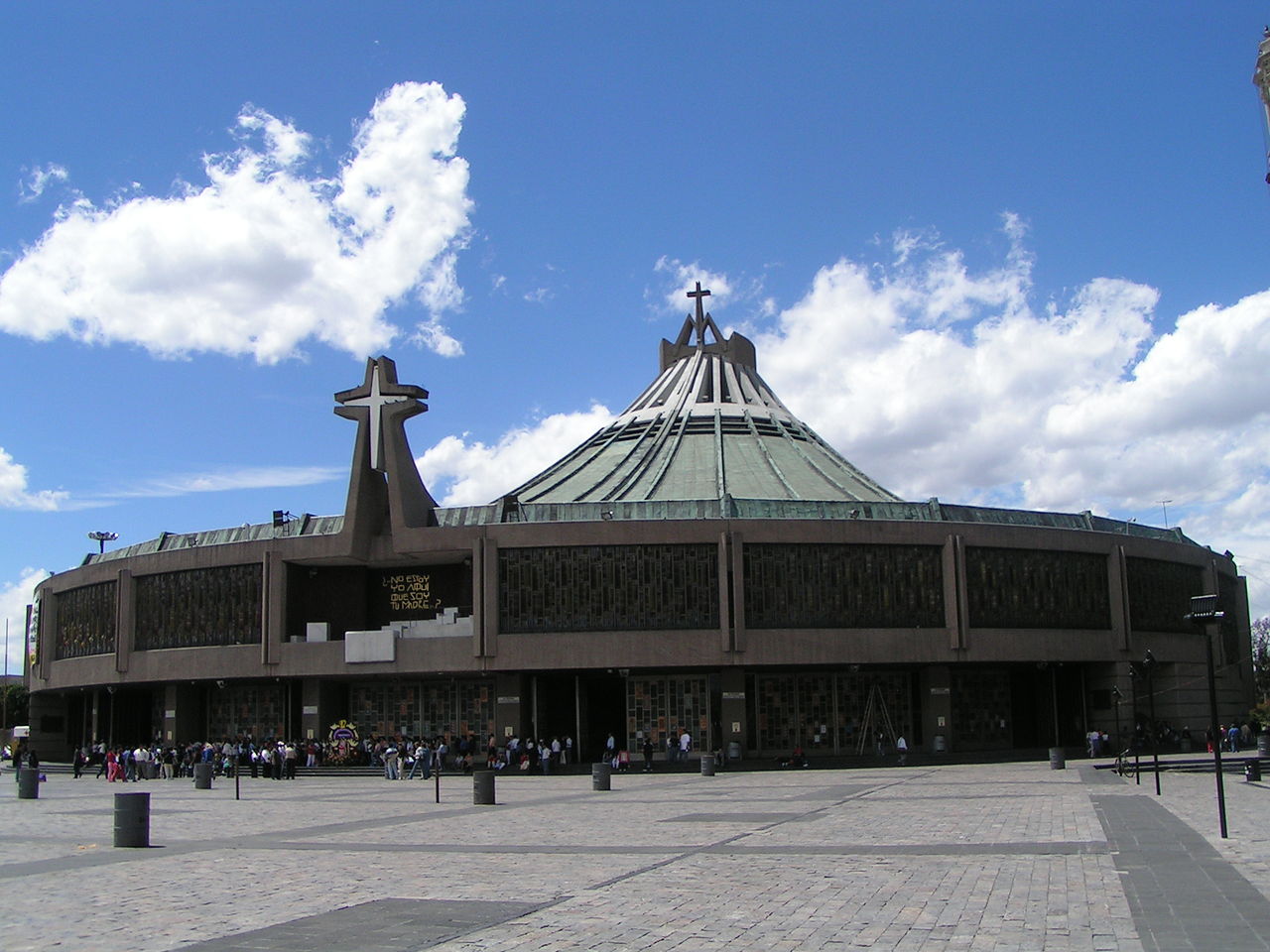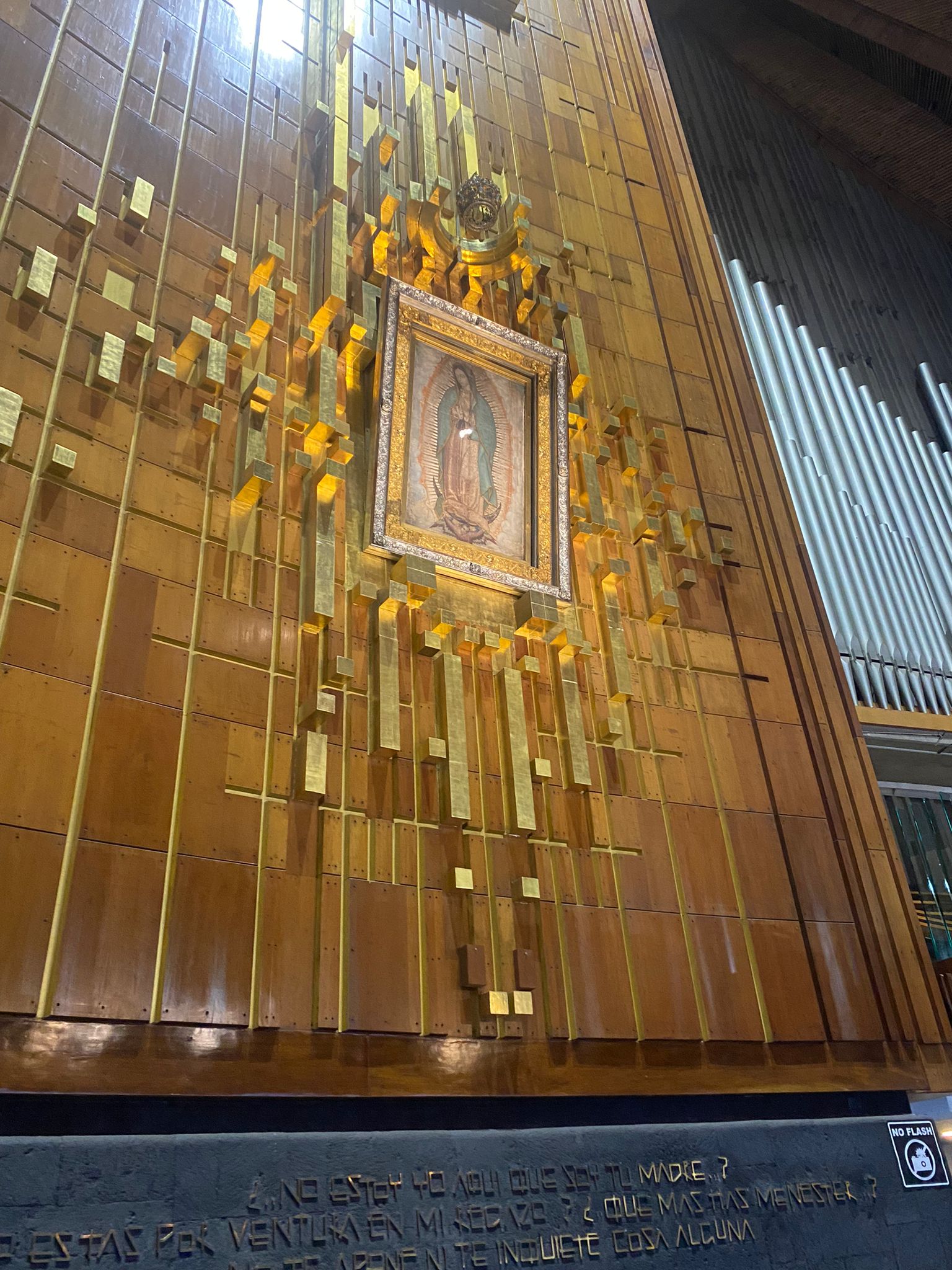The Tilma of Guadalupe
Karolina Aszyk-Treppa ![]()
University of Gdansk, Poland
Zbigniew Treppa ![]()
University of Gdansk, Poland
Also referred to as the Icon of Guadalupe or commonly the Virgin of Guadalupe (Spanish: Nuestra Señora de Guadalupe, Virgen de Guadalupe; English: Our Lady of Guadalupe, Virgin of Guadalupe), is an object through which Mary is venerated as the patron saint of the Americas. The object currently measures 172×107 cm and consists of two similar-sized pieces of cloth woven from agave fibres, of the species Agave popotule Zacc (Ernesto Sodi Pallares) or Agave lechuguilla Torr (Isaac Ochoterena, Alejandro Javier Molina), sewn together vertically. The cloth was a type of Indian mantle, which was called a tilma, and which, both in Pre-Columbian times and during the Conquista and the settlement of Europeans on the American continent, was an important part of the clothing and even identity of the Indians living in the territory of present-day Mexico (Chávez 2010, p. 251). After the image appeared on it, it became an object through which the Indians began to worship Christ and Mary in public.

Jesus’ presence in the painting is expressed through visual symbols characteristic of Pre-Columbian Mexican culture, while Mary is depicted in the painting in the traditional manner: surrounded by a nimbus, wearing the clothes we know from Eastern Christian icons. A seam runs through the centre of the painting, along Mary’s cloak (Old Greek: ὠμοφόριον, omophorion), connecting the two cloths. It begins where the cloak encircles the head, crosses a spot near the left wrist, continues downwards along the tunic (Old Greek: χιτών, chiton) and the horizontal depiction of the crescent, which is partly hidden under the folds, and then runs to the head of an angel with eagle’s wings, visible just below Mary’s feet. The figure of Mary is approximately 143 cm high.
The image seen on the Tilma of Guadalupe was miraculously created on 12 December 1531, at the conclusion of the first apparitions of Mary in American history, ten years after the Spanish conquest of the Aztec Empire. Later, some elements were applied to the cloth, covering the spaces of the original image. The owner of the mantle was Cuauhtlatoatzin, with the baptismal name Juan Diego, from the Chichimek tribe. He became the first Indian to be canonised by the Holy See. The image on his outer garment appeared at the bishop’s seat in Tlatelolco, a town near Tenochtitlán, the capital of the Aztec Empire. Both cities lay on an island formed by the Aztecs in Lake Texcoco. The city of Tenochtitlán was located in the southern and central part of the island, while Tlatelolco—at the northern end of the island. The appearance of the image on Juan Diego’s the Tilma is also linked to the hill →Tepeyac, where Mary appeared to him on several occasions. This event is described in the document Nican Mopohua, whose title in the language of the Indians of the region (Náhuatl) translates as “telling fact after fact”. The document was edited by don Antonio Valerian, a student of the Franciscan Colegio de la Santa Cruz in Tlatelolco and later head of the college. Nowadays, all the sites mentioned, including Tepeyac Hill, are located in the agglomeration of Mexico City—Ciudad de México.
The origin of the pigments that form the image seen on the obverse side of the Tilma has not yet been clarified. It is likely that the same pigments formed the configuration of irregular coloured spots on the side of its reverse. The obverse shows the original image together with retouches and additions in later times, and these include the flakes of gold that cover the rays of the nimbus and the silver that covers and magnifies the crescent under Mary’s feet. In the 1930s. Richard Kuhn, a biochemist who won the Nobel Prize in 1938 for his study of carotenoids (plant pigments), was the first to attempt to scientifically explain the origin of the pigments from the Guadalupe the Tilma. He analysed fragments of red and blue fibres from the Tilma. He found that there was no colouring in the fibres. The structure of the pigments is unique; they are neither of animal, nor of vegetable nor of mineral origin. Kuhn also ruled out the possibility of synthetic colouring, as this was developed three centuries after the creation of the image (Johnston 1981, p. 121). Microscopic examinations carried out between 1946 and 1966 revealed the absence of brush strokes on the surface of the cloth and the absence of the artist’s signature in the lower corner of the painting (Francisco Camps Ribera).
On the basis of the above data—contrary to the opinions of professional Mexican painters (including Miguel Cabrera) voiced since 1751, who had inspected the cloth—it was hypothesised that the Tilma image was not a painting. The hypothesis was confirmed by studies carried out with infrared (IR) light in 1979 by Philipp Serna Callahan and Jody Brant Smith. They showed that the cloth lacked traces of any sketch, which usually precedes the painting. The scholars claim that it is impossible to explain the colour intensity of the original structure of the painting, especially the colours of Mary’s clothing: of the blue-green cloak and the pink tunic. On the basis of microscopic studies of the cloth fibres, Callahan and Smith also found that two mutually exclusive observational results could not be reconciled. On the one hand, the characteristics of the colouring of the fibres suggest that coloured threads were used to create the image, from which the cloak was only later woven; on the other hand, weaving the Guadalupe the Tilma in this way seems impossible due to the finesse and complexity of the colours of the image. Callahan observed the existence of optical effects arising from the scatteried of light. The colours of the Tilma image are altered depending on the angle and distance of viewing: for example, the surface of Mary’s face appears white when viewed up close, while at a greater distance it appears grey-olive. An American scholar determined that the perception of the colours of an image resembles that when we see how the colours change when viewed from different angles—for example, [observing] the smooth surfaces of the wings of birds or butterflies and brightly coloured beetles (Johnston 1981, p. 132).
Kuhn and Callahan’s observations suggest that the colours on the Tilma are not from pigments (there are no pigments on the fibres), but are mainly (or only) derived from structural (i.e. optical) colours, which are produced by the scattering of light on microscopic structures formed on the surface of the fibres and in the voids, which—among other things—is similar to the colours of butterfly wings. This has not been confirmed experimentally (immersion of the fibre in a liquid with a high refractive index should neutralise the colour), but the details of Kuhn’s analysis are also unknown.
There is no answer to the question of whether this optical effect is caused by an unprecedented and unknown physical structure of the surface of the coloured fibres; nor is there an answer to the question of how they were formed. Similarly, scientists are unable to explain how it is that the Tilma has survived intact. The Tilma was woven from agave fibres, whose durability is described as a maximum of a few decades (Chávez 2010, p. 257); the Tilma’s current age—at least 490 years old—leads to great amazement. It is also impossible to explain the marked differences in the surface structure of the cloth, which only on the reverse side has the roughness and coarseness characteristic of agave fibres, while on the obverse side it has the smoothness and softness of silk (Chávez 2010, p. 258; Escalda 2001, p. 68). Since the 1956 study by Javier Toroello Bueno and Rafael Torijo Lavoignet using an ophthalmoscope, scholars have been puzzling over the optical riddle of the Madonna’s pupils. The scientists put the problem they encountered in the following words: If we direct the light of the ophthalmoscope at the pupil of the eye from the image of the Virgin Mary, the same light reflection [as that of the human eye] appears. As a result of this light reflection, the pupil illuminates with diffused light, producing a concave relief effect. Various oil and water colour paintings were examined with an ophthalmoscope and no reflections could be seen in any of them, whereas, according to Lavoignet, the eyes of the Virgin of Guadalupe give the impression of being alive (Johnston 1981, pp. 122–123; Smith 1994, p. 54). Javier Bueno and R. Lavoignet confirmed the results of the 1951 research by Carlos Salinas Chavaz, indicating the reflections of human figures in the eyeballs of the Guadalupe Tilma image of Mary, and the discovery in 1929 by Antonio Gonzales of the reflection of a man’s bust in the right eye on a high magnification photograph of the Tilma.
Carlos Chavaz was the first to use specialised apparatus to observe optical phenomena in the Tilma image. The decision to undertake such research was made almost immediately after A. Gonzales’ discovery, but due to the brutal persecution of the Church in Mexico, it did not become possible to implement it until 22 years later. Subsequent analyses have shown that the images of the reflections of human figures in the eyeballs of the image of Mary were created according to the knowledge of optical effects, which was unknown at the time of the formation of the image on the Tilma. This is indicated, among other things, by the asymmetrical way in which the two images visible on the surface of Mary’s eyes are positioned in relation to each other and by the distorted outline of the figures, which is consistent with contemporary knowledge of the reflection of objects on the outer surface of the eyeball.

The inexplicable physical structure of the pigments, which, despite the lack of preservatives, preserved the intensity of the colours, together with the properties of the cloth, the permanence of which seems to be related to the image integral to it, and the optical properties of such details of the image as the pupils of the image of Mary, among others, underlie the classification of the representation from the Tilma into the category of paintings of the acheiropoieta type, i.e. not-made-by-human-hand. Among other reasons for considering it an acheiropoieton is the manner of its creation, which is characterised in the Nican Mopohua, the source text for the apparitions from Mexico, as the effect of Mary appearing to Juan Diego. Juan Diego recounted—and the veracity of his words was confirmed by the authority of the bishop of the place—that the appearance of the image on his cloak was preceded by a request from Mary that he collects flowers blooming on the hill of Tepeyac, which, due to the winter season and the unparalleled beauty of the unknown species, was to be a sign to the bishop of the place, don Juan de Zumárraga, that a miracle had indeed occurred.
According to Juan Diego’s account, the flowers were carried by him in the Tilma to the bishop’s residence, where, in front of several witnesses, after being scattered in front of the bishop, an image appeared on the Indian’s mantle. This is described in the Nican Mopohua in a paragraph with editorial number 107:
Juan Diego unfolded his white cloak, for in it he kept the flowers he had collected. Immediately, all the various flowers of Castile spilled to the ground, and on the cloak at that moment was outlined the magnificent image of Mary, always Virgin, Mother of God Teotl. The same image that still exists today [1556—K.A.-T., Z.T.] and is kept in Her miraculous home, in Her chapel in Tepeyac, called Guadalupe.
Nican Mopohua 107
The present name of the building refers to the site of Mary’s apparitions in Guadalupe, Spain, where She is venerated through a small wooden statue, given with the help of St Isidore by Pope Gregory the Great (580) to St Leandro, Isidore’s brother. As a result of the Moorish invasion of 711, this statue was hidden along with the relics of St Fulgentius (in turn brother of St Isidore and St Leander). The statue of Our Lady of Guadalupe, linked by its fate to the biographies of the three holy brothers, remained concealed for more than 600 years, until it was finally lost and, according to chronicles, supernaturally found by a shepherd (1326). Following its discovery, it quickly became an object of veneration in Spain. The statue of Our Lady of Guadalupe must have been known to Bishop de Zumárraga of Mexico, who, hearing the name of Mary spoken in the Nahuatl language from the lips of Juan Bernardino, uncle of Juan Diego (who was miraculously healed by Mary during the course of the apparitions), had no doubt that he had heard: Guadalupe, although the name was: Coatlaxopeuch, which means: “I Trampled-Snake-With-Feet” (Nican Mopohua 119). Thus, although the Mexican apparitions of Mary were geographically linked to two places—Tepeyac and Tlatelolco—the term referring to the place of Mary’s apparitions close to the Spaniards on the Old Continent, Guadalupe was adopted.
The uniqueness of the apparition from Guadalupe, Mexico, is not only the physical properties of the image and the cloth, but also its message. It is surprising, for example, that people brought up in Aztec culture see a pregnant woman in the figure of Mary in the Guadalupe Image. The question posed by the authors of this entry as to how the fact of her pregnancy was interpreted by the Indians at the time of Mary’s apparition in Mexico was answered by the postulator in the canonisation process of Saint Juan Diego, Monsignor José Luis Guerrero. He stated that the Indians perceived Mary’s blessed state in the Guadalupe Image because the area around the womb was more intensely lit than other parts of the image. From this, the conclusion was drawn that new life, a new sun, would come for Mexico. This sun is new because in the painting it appears together with the stars and the moon. The Indians firmly believed that what happens between the stars and the moon always heralds the coming of the new world. Thus, the girl depicted on Juan Diego’s mantle brings a new world order (J.L. Guerrero).
The geometric floral form situated in the upper part of the tunic, under the black sash encircling the waist, identified by Father Mario Rojas of the Centre for Guadalupe Studies as the Mexican jasmine, which was called the flower of flute music by the indigenous people, also speaks of Mary’s pregnancy. This schematically depicted Mexican jasmine, placed in the central position of the painting, is a clear symbol of the quintessence of truth for the people of the Valley of Mexico. The flower of the sun, the most frequent symbol in the Aztec sacred books, the ordering principle (…), placed on Mary’s bosom, proclaims that from the Virgin Mary will be born the Sun of a new era (Osiński 2002, pp. 148–149).
During the apparitions from Guadalupe, Mexico, Mary used the Náhuatl language in her interactions with St Juan Diego and Juan Bernardino. As a result, the Indians were able to read the meanings encoded in the image, combining the content derived from signs specific to their visual culture with the content expressed verbally by Mary. This indicates the multimodal nature of the apparitions, composed of pictorial and verbal forms. The first modus of the message given in the apparitions of Guadalupe is the image that Mary revealed at the seat of the Bishop de Zumárraga, while the second consists in the verbal message, which is known from the accounts of St Juan Diego and Juan Bernardino. In both cases, Mary referred to the cultural roots of the Indians who had inhabited the area of present-day Mexico for hundreds of years, exemplified in the visual field by the visual signs of Mary’s pregnancy, and in the verbal field by, among other things, the reference to theological message contained in the name of the Aztec god Tloque Nahuace (Náhuatl: ‘close and together’), which was used by Mary in her first appearance on the hill of Tepeyac: I am Mary always Virgin, Mother of God, the true Teotl (…), the Giver of all that is near and together [tloque nahuace—K.A.-T., Z.T.] (Nican Mopohua 22).
In addition to the message addressed explicitly to the Indians, which is in keeping with their difficult time of loss of independence and religious conversion, the painting also contains a universal message. It becomes comprehensible when applying the classical methods of interpreting an image understood in terms of a visual text, methods which are used for reading the content of sacred icons of the Eastern tradition, with the latter always reflecting the biblical content. In the image of Mary of Guadalupe, we have a reference to two biblical women: the one trampling the serpent with her feet from Genesis (Gen 3:15) and the one clothed with the sun from the Apocalypse of Saint John (Rev 12:1–2). The biblical content read in this way is complemented by the Mexican names of Mary: Coatlaxopeuch (I-Trampled-the-Serpent-With-My-Feet) and Tlecuantlapcupeuh (She-Who-Comes-From-Light-As-Eagle-From-Fire).
Scientists, with the exception of one known documented case (José Solem Rosales), have not engaged in polemics regarding the authenticity of the Tilma of Guadalupe image. In 1982, J. Rosales published a report based on a visual observation he had made, in which he questioned the miraculous origin of the painting, but he failed to provide any scientific evidence to support his opinion. Although there is a lack of certainty among scientists regarding the origin of some parts of the painting, which can hypothetically be attributed to a natural origin, the biggest point of contention regarding the painting’s authenticity relates only to the issue of the possible use of primer as a base for the painting. According to J. Rosales, the cloth was primed with an irregularly applied primer before the painting was made, but this is strongly denied by Ph.S. Callahan, who carried out infrared light studies of the Tilma.
Phillipp S. Callahan also accused J. Rosales of failing to specify whether the irregular primer use he observed apply to the Tilma as a whole or only to certain areas of it—such as those not involving the figure of Mary—where, according to Ph.S. Callahan, there were only later painterly additions and retouches. These are indicated by some flaking of the binder, but only in retouched areas, most often along the line of the vertical seam and in areas thought to be later additions to the structure of the painting. Ph.S. Callahan himself expressed the opinion that it is likely that an angel and its Aztec tunic were added to the painting by human hand in the 17th century, which contradicts an analysis of a 16th century copy of the Guadalupe painting sent by Bishop Alonso de Montufar (successor to Bishop de Zumárraga) to Europe, on which the angel already appeared. (This copy was, among others, in the possession of the Spanish admiral Juan de Austria, who had it in his cabin during the naval battle of Lepanto in 1571, where the Christian fleet under his command was victorious over the superior forces of the most powerful Turkish fleet in the world at the time).
Neither the substrate of the painting (the Tilma) nor the painting itself has yet been examined with the full range of possible measures that are used when analysing different types of artefacts. Any study of the cloth requires the approval of its custodians at the Basilica of Our Lady of Guadalupe. Among the direct research work on the object, only Ph.S. Callahan’s analyses were undertaken on the initiative of a third party: the Tilma’s custodians had no influence on the course of the expertise. Today’s natural knowledge, merely from a technical point of view, cannot explain the process of formation of the image of Our Lady of Guadalupe.
The cult of the image of Our Lady of Guadalupe began to develop after the first inconspicuous chapel was built on the hill of Tepeyac, in which Juan Diego’s mantle with the image on it was placed. Its construction was the fulfilment of a request made by Mary during the apparitions to the bishop of the place through St Juan Diego. Mary said that the purpose of erecting the chapel was to bestow love, grace, help and protection on all people through it and to bring them solace in their distress, healing in their suffering and misfortunes (Nican Mopohua 23.25). The construction of the chapel was followed by the popularisation of the image of Mary of Guadalupe, and the subsequent mass conversion of Indians to the faith of the conquerors. This was largely due to the image’s appreciation of traditional Indian beliefs, infused by Mary with new Gospel content.
Not without influence on the increase in Indian conversions was the site of Mary’s apparitions, the hill of Tepeyac, which, prior to the conquest, had been the place of worship of the goddess Coatlique, to which Indians made mass pilgrimages. The indigenous believed that Coatlique was supposed to have conceived, without losing her virginity, the god of war Huitzilopochtli, who was constantly in battle with the forces of the cosmos, the moon and the stars, thus assuring the followers of the protection of the god Tonatiuha (Náhuatl: ‘sun’). This belief was reflected in the ritual of burning human hearts plucked from thousands of living victims in sacrifice by the priests of Huitzilopochtli, which was supposed to provide the deity with the strength to win victories. Mary, appearing in the Guadalupe image, replaced the old blood cult, showing the Indians the value of the sacrifice of Jesus Christ as the only effective atoning sacrifice being the source of true life in God for the sins of all people.
Today, the centre of devotion to Our Lady of Guadalupe is the Basilica of Nuestra Señora de Guadalupe (The Basilica of Our Lady of Guadalupe), together with the complex of chapels and sacred buildings that make up Mexico’s national shrine. The basilica is located near the apparition hill, Tepeyac, which is now in one of the districts of the Mexican capital, some 15 kilometres outside its historic boundaries from the time of the apparition. Millions of pilgrims visit the shrine every year: most come here on 12 December, the day of the liturgical commemoration of Our Lady of Guadalupe. In terms of the number of visitors, the Basilica of Guadalupe is the second most visited basilica in the world, after St Peter’s Basilica in Rome, which is mainly due to the Tilma of St Juan Diego displayed in its presbytery.


References
Acta de la Inspección directa de la Imagen de Nuestra Señora de Guadalupe, Basílica de Guadalupe 1998.
Aszyk K., Treppa Z., interview with rev. prelate José Luis Guerrero, postulator quiding the cause for the canonisation of Cuauhtlatoatzin (Juan Diego), IX 2004.
Branding D.A., Mexican Phoenix: Our Lady of Guadalupe. Image and Tradition Across Five Centuries, Cambridge–New York 2001.
Callahan Ph.S., The Tilma Under Infra-Red Radiation: An Infrared and Artistic Analysis of the Image of the Virgin Mary in the Basilica of Guadalupe), Washington 1981, Guadalupan Studies, No. 3.
Chávez E., Drugi Całun. Matka Boża z Gwadelupy – wyzwanie dla nauki, historii i wiary, przekł. A. Fijałkowskia-Żydok, Kraków 2010.
Escalda X., Guadalupe, arte y esplendor, México 2001.
González Fernández F., Chávez Sánchez E., Guerrero Rosado J.L., El Encuentro de la Virgen de Guadalupe y Juan Diego, 2nd ed., México 1999.
Henderson G.G., The Apparition of Our Lady of Guadalupe: The Image, The Origin of the Pilgrimage, “Marian Studies” 1983, Vol. 34, pp. 35–47.
Johnston F.W., The Wonder of Guadalupe: The Origin and Cult of the Miraculous Image of the Blessed Virgin in Mexico, Chulmleigh 1981.
Nican Mopohua, ed. A. Valeriano, 1556, [in:] Ukryci w moich skrzyżowanych ramionach. Przesłanie z Guadalupe, oprac. H. Multhaupt, E. Prégardier, przeł. J. Szpakowska, Warszawa 2002.
Ochoterena I., Análisis de unas fibras del ayate de Juan Diego o Icono de Nuestra Señora de Guadalupe, realizado por el Instituto Biología de la Universidad Nacional Autonoma de México, México, 7 June 1946 r., Dirección del Instituto de Biologia UNAM, officio 242, exp. 812.2/–2.
Osiński K., Autoportret z Guadalupe, Warszawa 2002.
Salinas C., Juan Diego en los ojos de la Santísima Virgen de Guadalupe, México 1974.
Salinas C., de la Mora M., Descubrimiento de un Busto Humano en las Ojos de la Virgen Maria de Guadalupe, Mexico City 1976.
Sennott T.M., The Tilma of Guadalupe: A Scientific Analysis, 2 XII 2011, [on-line:] https://web.archive.org/web/20170608181934/http://www.motherofallpeoples.com/2011/12/the-tilma-of-guadalupe-a-scientific-analysis – 26 VII 2022.
Smith J.B., The Image of Guadalupe, 2nd rev. ed., Macon 1994.
Treppa Z., Meksykańska symfonia. Ikona z Guadalupe, Warszawa 2006.
Vaillant G.C., Aztekowie z Meksyku. Powstanie, rozwój i upadek narodu azteckiego, przeł. J. Maliszewska-Kowalska, Warszawa 1965.
Sources of Images
1. Wikimedia Commons, https://commons.wikimedia.org/wiki/File:Matka_Boza_z_Guadalupe.jpg (public domain)
2. Wikimedia Commons, https://commons.wikimedia.org/wiki/File:MIguel_Cabrera_-_Fiel_retrato_do_venerável_Juan_Diego.jpg (public domain)
3. Wikimedia Commons, CC License, źródło: https://commons.wikimedia.org/wiki/File:Basilica_of_Our_Lady_of_Guadalupe_(new).JPG (Jan Zatko, CC BY-SA 3.0)
4. Collection and ownership of the Polish Syndonological Centre in Krakow
